
Rio Grande County is a county located in the U.S. state of Colorado. As of the 2020 census, the population was 11,539. The county seat is Del Norte. The county is named for the Rio Grande, which flows through the county.

Rio Grande do Norte is one of the states of Brazil, located in the northeastern region of the country, occupying the northeasternmost tip of the South American continent. Because of its geographic position, Rio Grande do Norte has a strategic importance. The capital and largest city is Natal. It is the land of the folklorist Luís da Câmara Cascudo. Its 410 km (254 mi) of sand, much sun, coconut palms and lagoons are responsible for the fame of beaches. Rocas Atoll, the only such feature in the Atlantic Ocean, is part of the state. The main economic activity is tourism, followed by the extraction of petroleum, agriculture, fruit growing and extraction of minerals, including considerable production of seasalt, among other economic activities.

Natal is the capital and largest city of the state Rio Grande do Norte, located in northeastern Brazil. According to IBGE's 2020 estimate, the city had a total population of 890,480, making it the 19th largest city in the country. Natal is a major tourist destination and an exporting hub of crustaceans, carnauba wax and fruits, mostly melon, sugar apple, cashew and papaya. It is the country's closest city to Africa and Europe, with its Greater Natal International Airport connecting Natal with many Brazilian cities and also operating some international flights. The city was one of the host cities of the 2014 FIFA World Cup.

Ponta Negra is a beach and neighborhood located in the Brazilian city of Natal, the capital of the state of Rio Grande do Norte. Located in the extreme south of the beach is the Morro do Careca, a large dune and a landmark of the city. Located in the extreme north of the beach is the Via Costeira, a coastal road that connects Ponta Negra with several other beaches of the city, such as Areia Preta and Praia dos Artistas.
The Estádio Francisco Stédile, usually known as the Estádio Centenário, is a multi-use stadium in Caxias do Sul, Brazil. It is currently used mostly for football matches. The stadium has a capacity of 30,802 people. It was built in 1976. The stadium was named after Francisco Stédile, who was Caxias' president during its construction. The stadium is nicknamed Centenário because it honors the centennial anniversary of the Italian colonization of Rio Grande do Sul.

Rio Grande National Forest is a 1.86 million-acre (7,530 km²) U.S. National Forest located in southwestern Colorado. The forest encompasses the San Luis Valley, which is the world's largest agricultural alpine valley, as well as one of the world's largest high deserts located around mountains. The Rio Grande rises in the forest, and the Continental Divide runs along most of its western border. The forest lies in parts of nine counties. In descending order of land area within the forest they are Saguache, Mineral, Conejos, Rio Grande, Hinsdale, San Juan, Alamosa, Archuleta, and Custer counties. Forest headquarters are currently located in Monte Vista, Colorado, but plan to move to Del Norte. There are local ranger district offices in Del Norte, La Jara, and Saguache.

Rio Grande is a municipality (município) and one of the oldest cities in the Brazilian state of Rio Grande do Sul. It was the state capital from 1835 to 1845. It is the most important port city in the state and has one of the most important maritime ports in Brazil.
Estádio Maria Lamas Farache, usually known as Frasqueirão is a multi-purpose stadium in the Brazilian city of Natal, Rio Grande do Norte. It is currently used mostly for football matches. The stadium has an initial capacity of 18,000 people and will be expanded to 24,000 spectators.
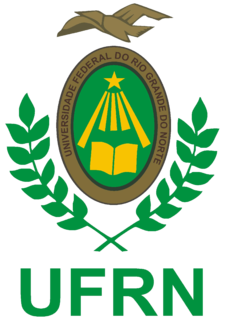
The Federal University of Rio Grande do Norte is a public Brazilian university funded by the Brazilian federal government, located in the city of Natal, Rio Grande do Norte, Brazil.

The Amazing Race: A Corrida Milionária was a Brazilian version of the popular franchised reality television show The Amazing Race. Hosted by Rony Curvelo, it was independently produced and aired in a purchased time slot in the Brazilian television network RedeTV!. The show premiered on 13 October 2007 and ended on 5 January 2008.
The Potenji River, meaning "river of the shrimps" in Tupi, is the principal river in the state of Rio Grande do Norte (Brazil). Its delta, that discharges in the coastline of Natal, was soon discovered by the first colonists that used to penetrate into the territory with their vessels. They named the river Rio Grande because of its large channel and extension, being the origin of the name of the "capitania hereditária" of Rio Grande do Norte of that time.

Touros is a municipality in Rio Grande do Norte, Brazil. It is known as "Brazil's Corner" because it is located at the northeast corner of the country, being the closest South American city to Africa. Touros has many fish, and there is a nearby seawater basin in the ocean formed by banks of coral.
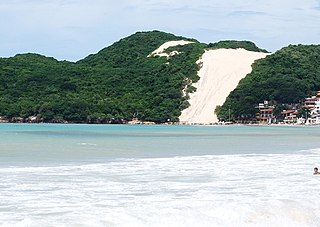
The Morro do Careca is a large dune located in the city of Natal in Brazil. It is the main symbol and a common sight on tourist postcards of the city and the state of Rio Grande do Norte. It has a height of 120 metres (390 ft), with a margin determined by vegetation. It is located in the extreme south of Ponta Negra – the capital's most famous beach.
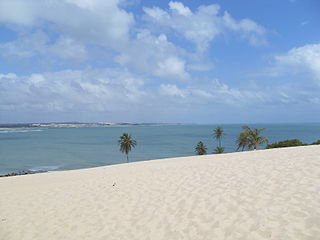
The Natal Dunes State Park "Journalist Luiz Maria Alves", or simply the Dunes Park is a state park in the state of Rio Grande do Norte in the Northeast Region of Brazil. It protects an area of dunes and native vegetation along the coastal highway.
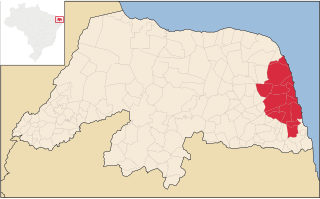
The Greater Natal is a metropolitan area located in Rio Grande do Norte state in Brazil. It consists of nine municipalities, including the capital, Natal.

Parque da Cidade Dom Nivaldo Monte, colloquially known as Parque da Cidade, is a park in Natal, Rio Grande do Norte, Brazil. The City Park covers an area of 64 hectares, aimed at environmental preservation and education, and comprises eco-trails, jogging lanes, library, auditorium, orchidarium and more. The symbol of the Park is the central tower, 45 meter high, which houses the Memorial of the city. The Memorial maintains exhibits about the history and development of Natal.
Pedra Grande is a municipality in the state of Rio Grande do Norte in the Northeast region of Brazil.

Macaíba is a municipality in the state of Rio Grande do Norte in the Northeast region of Brazil.
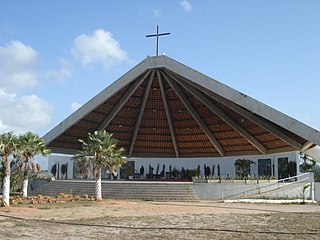
São Gonçalo do Amarante is a municipality in the state of Rio Grande do Norte in the Northeast region of Brazil.

The Legislative Assembly of Rio Grande do Norte is the unicameral legislature of the State of Rio Grande do Norte in Brazil. It is composed of 24 state deputies who are elected by proportional representation.


















